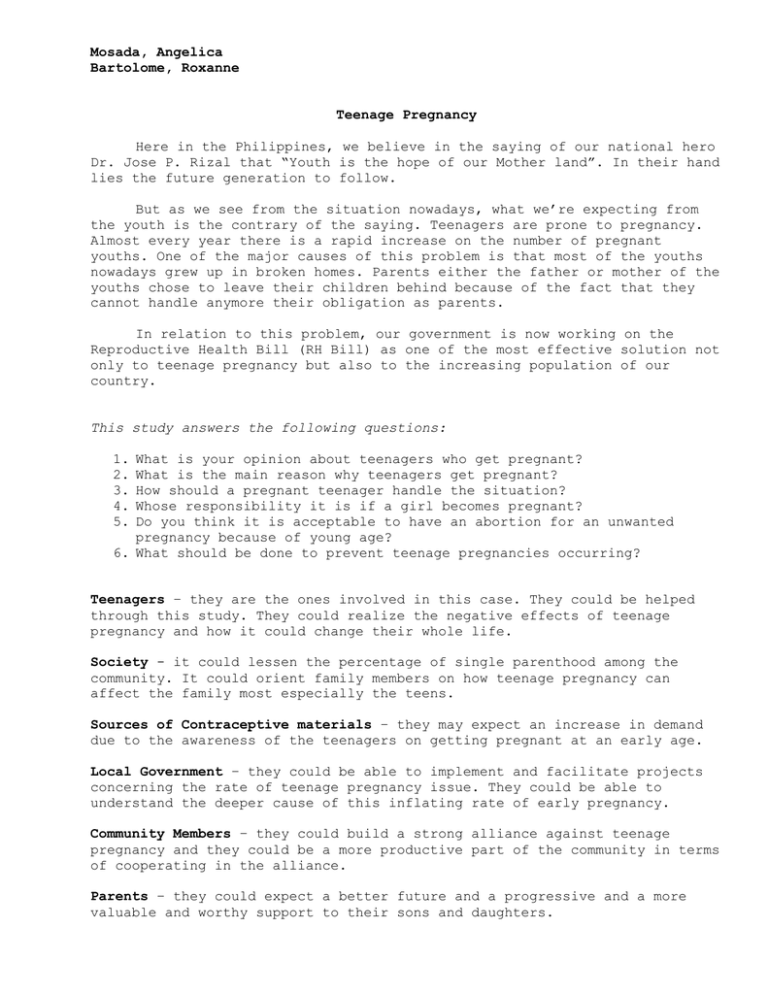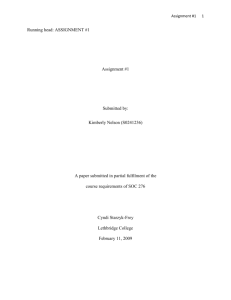File
advertisement

Mosada, Angelica Bartolome, Roxanne Teenage Pregnancy Here in the Philippines, we believe in the saying of our national hero Dr. Jose P. Rizal that “Youth is the hope of our Mother land”. In their hand lies the future generation to follow. But as we see from the situation nowadays, what we’re expecting from the youth is the contrary of the saying. Teenagers are prone to pregnancy. Almost every year there is a rapid increase on the number of pregnant youths. One of the major causes of this problem is that most of the youths nowadays grew up in broken homes. Parents either the father or mother of the youths chose to leave their children behind because of the fact that they cannot handle anymore their obligation as parents. In relation to this problem, our government is now working on the Reproductive Health Bill (RH Bill) as one of the most effective solution not only to teenage pregnancy but also to the increasing population of our country. This study answers the following questions: 1. 2. 3. 4. 5. What is your opinion about teenagers who get pregnant? What is the main reason why teenagers get pregnant? How should a pregnant teenager handle the situation? Whose responsibility it is if a girl becomes pregnant? Do you think it is acceptable to have an abortion for an unwanted pregnancy because of young age? 6. What should be done to prevent teenage pregnancies occurring? Teenagers – they are the ones involved in this case. They could be helped through this study. They could realize the negative effects of teenage pregnancy and how it could change their whole life. Society - it could lessen the percentage of single parenthood among the community. It could orient family members on how teenage pregnancy can affect the family most especially the teens. Sources of Contraceptive materials – they may expect an increase in demand due to the awareness of the teenagers on getting pregnant at an early age. Local Government – they could be able to implement and facilitate projects concerning the rate of teenage pregnancy issue. They could be able to understand the deeper cause of this inflating rate of early pregnancy. Community Members – they could build a strong alliance against teenage pregnancy and they could be a more productive part of the community in terms of cooperating in the alliance. Parents – they could expect a better future and a progressive and a more valuable and worthy support to their sons and daughters. Non-Government Organization – they could more stabilize their goals on this sector and comply an efficient purpose on execution of ideas from which this study focuses. They could be more sufficient in terms of project planning and data analysis of social factors of teenage pregnancy. Others – they would get a broader knowledge on how the teenage pregnancy work in the society. Risks There are many reasons teen pregnancies should be avoided. Here’s a low down on the facts: • Risk for malnutrition Teenage mothers tend to have poor eating habits and are less likely to take recommended daily multivitamins to maintain adequate nutrition during pregnancy. They are also more likely to smoke, drink or take drugs during pregnancy, which can cause health problems for the baby. • Risk for inadequate prenatal care Teenage mothers are less likely to seek regular prenatal care which is essential for monitoring the growth of the fetus; keeping the mother’s weight in check; and advising the mother on nutrition and how she should take care of herself to ensure a healthy pregnancy. According to the American Medical Association, babies born to women who do not have regular prenatal care are 4 times more likely to die before the age of 1 year. • Risk for abortion Unplanned pregnancies lead to a higher rate of abortions. In the United States, nearly 4 in 10 teen pregnancies (excluding those ending in miscarriages) are terminated by abortion. There were about 274,000 abortions among teens in 1996. In the Philippines, although abortion is illegal, it would shock you to know that we even have a higher abortion rate (25/1,000 women) compared to the United States where abortion is legal (23/1,000 women). For sure, there are more abortions that happen in our country that are not even reported. Backdoor abortions are resorted to with untrained “hilots” with questionable sterility procedures, increasing the possibility for tetanus poisoning and other complications. • Risk for fetal deaths Statistics of the Department of Health show that fetal deaths are more likely to happen to young mothers, and that babies born by them are likely to have low birth weight. • Risk for acquiring cervical cancer The Human Papillomavirus (HPV) is a sexually-transmitted, wart-forming virus that has been implicated in cancer of the cervix. This is the most common cancer in women secondary to breast cancer. Women who are at increased risk for acquiring this are those who engage in sex before 18, have a pregnancy at or younger than 18, or have had at least 5 sexual partners, or have had a partner with at least 5 sexual partners. If you start sex at an early age, you have a higher likelihood of going through several sexual partners before you settle down, thus increasing your exposure to acquiring the virus and acquiring cervical cancer. The men can get genital warts from this virus and can certainly pass it on to their partners, thus increasing her risk for cervical cancer. Is that something you would want to gift to your wife with on your honeymoon? There is a to test women (HPV Digene test) but no test for the man so you can’t know if you have it. Using the condom does not confer protection against acquiring this virus since the condom cannot cover the testes where the warts can grow and proliferate. (Conclusion) • RISKS for the teen mother Teen mothers are more disadvantaged, on average, than their same-age counterparts. Teenage pregnancies are often associated with an increased rate of delinquent behaviors including alcohol and substance abuse. To begin with, majority of them belong to the low income group. Teenage births are associated with lower annual income for the mother, 80 percent of whom eventually rely on welfare. With early termination of formal education comes limited employment opportunities. However, they have the responsibility of having to fend for their children before they even ever planned to. In hiring, an employer may lean toward someone without a child versus someone who is already with one just because there are more chances of absences with the latter when her child becomes sick. They also face greater financial difficulties and marital conflict. With a lower capacity for earning and less emotional maturity, relationships are under more stress for breaking. Young unmarried mothers also face social stigmas that can have harmful psychological and social impact. • Risk for the baby Children of teen moms also face negative health, cognitive, and behavioral outcomes. This may result from lack of maturity, and emotional quotient or simply from ignorance due to a lack of life’s experiences. Children born to teenage mothers are less likely to receive proper nutrition, health care, and cognitive and social stimulation. As a result, they may have an underdeveloped intellect and attain lower academic achievement. Children born to teenage mothers are at greater risk for abuse and neglect. Boys born to teenage mothers are 13 percent more likely to be incarcerated whereas girls born to teenage mothers are 22 percent more likely to become teenage mothers. CONTRIBUTING FACTORS Educational failure, poverty, unemployment and low self-esteem are understood to be negative outcomes of early childbearing. These circumstances also contribute to the likelihood of teen pregnancy. For example, recent studies suggest that most adolescent mothers have already dropped out of school before they become pregnant. On the other hand, adolescents still enrolled in school when they give birth are as likely to graduate as their peers. It is not clear how well the adolescents with the problems would have fared in the future even without early parenthood. Following are some of the contributing factors or causes of teenage pregnancy: 1) Lack of Parental Guidance: Most people evade their children from talking about sex. In some cases, they provide false information regarding sex and discourage their children to participate in any informative discussion about sex. In some cases, teenage mothers are not well educated about sex before getting pregnant and thus this leads to lack of communication between the parents and the children. 2) Adolescent Sexual Behavior: Among the adolescents, peer pressure is a major factor that encourages the teenage boys and girls to indulge in sexual activities. Early dating, as early as 12 years of age, is another factor that contributes to teen pregnancy. 3) Inadequate Knowledge about Safe Sex: Most adolescents are unaware of safe sex. They probably have no access to the traditional methods of preventing pregnancy. And the main reason behind is that they are either too embarrassed or fear to seek information about it. 4) Exploitation by Older Men: This is another major factor that contributes to pregnancy among the teenagers. Those girls who date older men are more likely to become pregnant before they attain womanhood. Rape, sexual exploitations etc. also takes place that leads to unwanted pregnancy among teenage girls. 5) Socio Economic Factors: Teenage girls who belong to the poor families are more likely to become pregnant. Researchers have found that even in the developed countries teenage pregnancy occurs most commonly among the deprived sections. Respondents The respondents of this research study are the teenage students of the University of the Cordilleras and some parents that we’ve encountered. SUMMARY Specifically, the sought answers about the profile of teenage students in terms of the age when they became sexually active, current situation in the pregnancy, how the pregnancy was done – planned or not, thought of aborting the baby, rate of substantiality of contraceptive materials, effects of teenage pregnancy in the teen’s health, knowledge about the availability of free condoms, how to support the child’s financial needs, partner’s occupational status, management of the situation, pursuance of education, and the dignity and respect of the teen’s social community. CONCLUSIONS The following conclusions were formulated based on the findings of the study and are presented. 1. The rate of teenage pregnancy in Baguio City is very much alarming. It has been observed that the rate of teenage pregnancy is increasing because of curiosity and peer pressure. 2. Most female are sexually active at the age of 11-15. 3. Teenagers who are engaged at teenage pregnancy mostly are drop out of school. 4. Teenagers are engaged in this activity due to lack of knowledge about the consequence they are about to face. 5. Teenagers still depend on their parents. 6. They don’t know what kind of occupation they will have. RECOMMENDATIONS Based on the conclusions on the study, the following recommendations are hereby presented. 1. Every man and woman has the right to decide what he/she will take on his life. Just be that you can stand all the consequences in your every action. 2. Teenage pregnancy is not an easy thing. You should have the knowledge about this and be aware that it has dangerous effects on a teenager’s life. 3. There is no hindrance in anticipating in this situation. Teenage pregnancy among today’s Filipino youth The National Youth Commission, supported by the Department of Health and the World Health Organization, convened the 2014 National Summit on Teen Pregnancy last April 24. This summit, which saw the active participation of adolescent youth, delivered a clear message: Adolescent sexual and reproductive health (ASRH), or the lack thereof, is fast becoming the defining issue of this generation of young Filipinos. Without a robust response from all stakeholders, the Philippines is on track toward a fullblown, national teenage pregnancy crisis. Staggering facts support this call for concern. Recent (2014) data from the Philippine Statistical Authority (PSA) reveal that every hour, 24 babies are delivered by teenage mothers. According to the 2014 Young Adult Fertility and Sexuality (YAFS) study, around 14 percent of Filipino girls aged 15 to 19 are either pregnant for the first time or are already mothers— more than twice the rate recorded in 2002. Among six major economies in the Association of Southeast Asian Nations, the Philippines has the highest rate of teenage pregnancies and is the only country where the rate is increasing, per the United Nations Population Fund. According to Josefina Natividad, YAFS coordinator and director of the University of the Philippines Population Institute, young Filipinos have limited access to sex education and ASRH services, especially if they are underage and unmarried. Seventy-eight percent are not using any form of contraception or protection against sexually transmitted diseases and infections when they are having sex for the first time. While government programs aim to delay the beginning of childbearing and hasten fertility decline, teenage pregnancies continue to increase. Perhaps it is really time for a new and more collaborative strategy? Data show that pregnant teenagers in the Philippines are mostly 17 to 19 years old. They live with their mothers, parents, or relatives. The father of the child is, in most cases, a teenage boy. Reasons for becoming pregnant among teenagers include: unplanned sexual encounters (“getting caught up in the moment”) and peer pressure; lack of information on safe sex; breakdown of family life and lack of good female role models in the family; and absence of accessible, adolescent-friendly clinics. Teenagers from poor backgrounds are disproportionately represented among pregnant teenagers. However, experts have argued that teenage pregnancy should be understood as a symptom of dire economic conditions rather than a cause of it. Teenage pregnancy perpetuates the cycle of poverty and inequality because most pregnant teenagers have no source of income and face greater financial difficulties later in life. This is because they drop out of school and are less likely to pursue further education or skills training. Teenage mothers face critical health risks, including: inadequate nutrition during pregnancy due to poor eating habits; dangers associated with the reproductive organs not ready for birth; and maternal death due to higher risk of eclampsia, among others.




